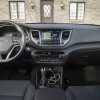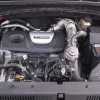The Hyundai Tucson has never been a real serious threat in the compact crossover segment. It isn’t that Hyundai wasn’t trying. They offered a lot of equipment at a low price and went with a unique design. But even with these traits, the Tucson wasn’t able to make a sizable dent into the compact crossover market where the likes of the Honda CR-V, Ford Escape, and Subaru Forester rule the roost. Hyundai isn’t giving up the fight, though. Last year, they launched the third-generation Tucson to make some inroads in the class. As we said in our first drive back in August, “it may be that the 2016 Hyundai Tucson can be considered one of the best in its class.” Let's see how we feel when we revisit the 2016 Tucson after some time has passed.
To make the Tucson standout in a crowded class, Hyundai has put a lot of effort into the Tucson’s design. There is a fair amount of European influence with sharp lines and an uncluttered look. Hyundai’s trademark elements such as a large hexagonal grille and slim headlights are here. A set of 19-inch alloys on the Limited are designed in such a way that it looks like an airplane propeller. The design work has paid off as the Tucson is one of the sharpest looking models in the class.
The Tucson’s interior doesn’t have the same flair as the exterior which is quite a shame. Is isn’t to say the interior is bad; there is a good mix of hard and soft materials, and controls are arranged in a logical fashion. But I found myself wishing Hyundai would take a small risk and add something special to the interior.
Our Tucson Limited tester came with leather seats with power adjustments for the front. Comfort and support levels are excellent. In the back, the Tucson offers plenty of head and legroom for most passengers. As we noted in our first drive, the Tucson loses out in cargo space. Open the tailgate and you’ll be greeted with 31 cubic feet. Fold the rear seats and space increases to 61.9. Competitors such as the Honda CR-V (35.2, 70.9 cubic feet), Subaru Forester (34.4, 74.7 cubic feet), and Toyota RAV4 (38.4, 73.4 cubic feet) offer more space.
When it comes to technology, the Tucson Limited does very well. There is an eight-inch touchscreen with the latest version of Hyundai’s infotainment system. We like this system as it is one of the easier systems to use thanks to large touchpoints and buttons under the screen to take you to the various parts of the system. One thing we are slightly disappointed is that you cannot option the larger screen on the Sport trim, which slightly hurts Hyundai’s value argument.
Most Hyundai Tucsons will come equipped with a turbocharged 1.6L four-cylinder producing 175 horsepower and 195 pound-feet of torque. This is paired with a seven-speed dual-clutch automatic and the choice of either front or all-wheel drive. The turbo engine is potent thanks to the torque being available across a wide range (1,500 to 4,500 rpm). This means the Tucson is able to scoot along when you are trying to make a pass or leaving from a stop. The engine is also very refined with very little noise coming into the cabin.
Sadly we cannot say the same about the dual-clutch transmission. Unlike the transmission we tried out on our first drive, the one in our test Tucson had issues of hesitating when leaving a stop and taking its sweet time to downshift whenever we needed to make a pass. At least upshifts were quick and smooth. Now when we turned in our Tucson tester, we learned that Hyundai issued an update for the transmission to fix the hesitation issue. If the Tucson was built before November 17, 2015 - which we suspect ours was - Hyundai’s dealers would perform the update on the vehicle. Tucsons built after November 17th have the update installed.
The Hyundai Tucson Limited AWD is rated by the EPA at 24 City/28 Highway/26 Combined. Our average for the week landed around 26 MPG. Those who want to eek out a few more MPGs should look at the Tucson Eco that comes with some fuel saving tricks such as lighter wheels to improve fuel economy to 26 City/33 Highway/29 Combined for the front-wheel drive model. All-wheel drive models see a small decrease in fuel economy numbers.
One thing that hasn’t changed from our first drive impressions is the Tucson’s ride and handling characteristics. Over Michigan’s terrible roads with endless bumps and potholes, the Tucson’s suspension was able to iron them out and provide a smooth ride. An extraordinary feat when you take into account the Tucson Limited feature a set of 19-inch wheels. Handling is impressive for a Hyundai with little body roll and the vehicle feeling planted. The only item we wished Hyundai would work on is the steering. There is still a slight dead zone when beginning to turn the wheel. At least some weight does appear the further you turn.
It seems Hyundai has mostly hit it out of the park with the new Tucson. Not quite. The big issue for the Tucson is the value argument. Our Limited all-wheel drive came with a base price of $31,300. The as-tested price landed around $34,945 with the Ultimate package that adds HID headlights, ventilated front seats, heated rear seats, lane departure warning, and a panoramic sunroof. This about the average price you would expect for other loaded small crossovers.
It is only when you drop down to other trims that you begin to realize the Tucson isn’t as a great of a value as you might think. For example, the Eco and Sport don’t come with any options. The only items you get to choose are color and whether you want front or all-wheel drive. If you want navigation or dual-zone climate control on the Sport, you’re out of luck.
That isn’t to say there aren't a lot of good things to the Tucson because there are. It stands out with some of the sharpest looks in the class and the turbo engine is one of best we have driven. Hyundai also deserves some kudos for getting the ride and handling balance just right. But the Tucson has a value problem that could drive some folks away, along with a small cargo area for the class.
The 2016 Tucson is good, but it isn’t the slam dunk we thought it was.
Cheers: Exterior design that stands out, turbo engine, nice balance between sport and comfort
Jeers: Value argument tough to argue on lower trims, small rear cargo area, interior design could use some more flair.
Disclaimer: Hyundai Provided the Tuscon, Insurance, and One Tank of Gas
Year: 2016
Make: Hyundai
Model: Tucson
Trim: Limited AWD
Engine: Turbocharged 1.6L GDI Four-Cylinder
Driveline: Seven-Speed Dual-Clutch Automatic, All-Wheel Drive
Horsepower @ RPM: 175 @ 5,500
Torque @ RPM: 195 @ 1,500 - 4,500
Fuel Economy: City/Highway/Combined - 24/28/26
Curb Weight: 3,710 lbs
Location of Manufacture: Ulsan, South Korea
Base Price: $31,300
As Tested Price: $34,945 (Includes $895.00 Destination Charge)
Options:
Ultimate Package for Limited - $2,750.00










-3707742431.jpg.06edf8e14f4ccf35c60d4774a543cc11.jpg)


Recommended Comments
There are no comments to display.
Join the conversation
You can post now and register later. If you have an account, sign in now to post with your account.
Note: Your post will require moderator approval before it will be visible.